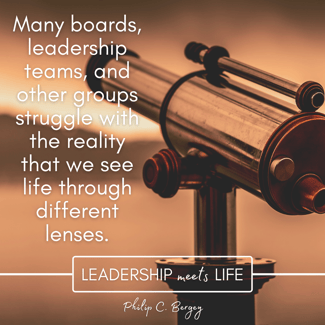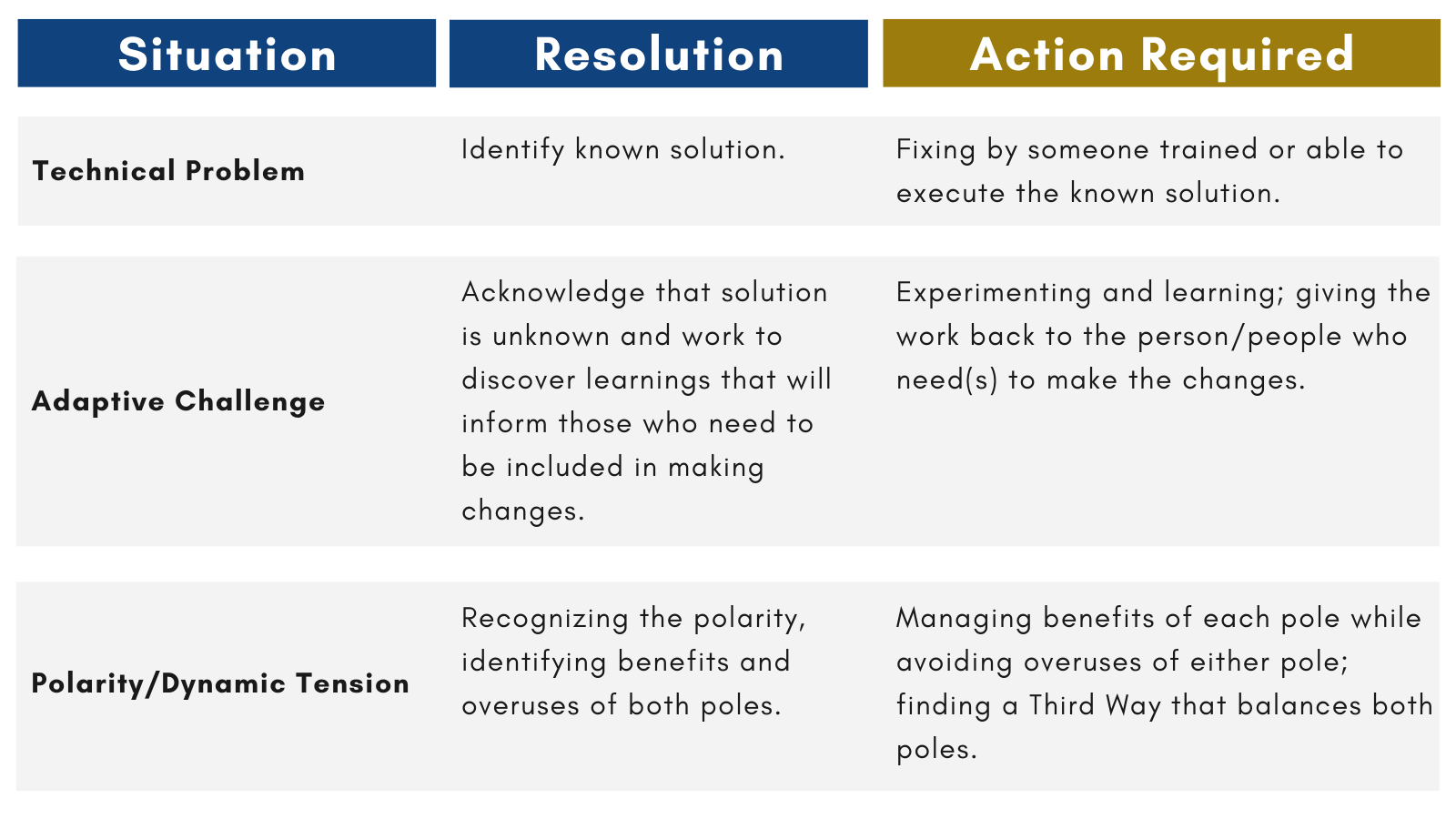
A Story
The boardroom was getting increasingly tense. CEO Liz Drum was sure this board meeting would end as frustratingly as too many previous ones over the past year. Seventeen board members and three staff. Two hours into the conversation and Liz was convinced the board members were having multiple conversations—simultaneously!
Tex was representative of one of the conversations. “I just don’t understand why we can’t get this problem fixed. We’ve talked about it before, and frankly, I was frustrated when I saw it on the agenda again. Three months ago, we hashed this out, and I assumed Liz had enough information to put this to bed. Am I missing something?”
Tex’s frustration and tidy solution were too much for Adriana. She looked up from her doodling and faced Tex squarely, took a deep breath, and said:
“Look, Tex, maybe you think this is a simple problem, but I don’t. And I doubt I’m the only one in the room who feels this way. I don’t love talking about the same ‘problem’ over and over, but I believe we’re making progress. We’re getting a better understanding of the challenge before us.”
Adriana continued. “And Liz implemented one aspect of this challenge using the clarity we got at the meeting you mentioned. That’s the best she could do at this point. We are learning our way into the rest of the challenge. Further, I don’t believe this is simply a board problem. We need to engage our stakeholders. There’s a lot of learning that needs to happen before we can take any next steps.”
She exhaled as quietly as she could, looked down at her agenda, and began doodling again.
Pat was sitting across from Adriana and Tex. She sighed deeply. Board chair Bill Turner looked at Pat, and aiming for some levity in the room, said: “Wow, Pat, that was a deep sigh. Are you willing to share your wisdom?”
“Well,” Pat began, “if you must know, I have a third way of viewing our conversation.”
“Do tell,” Bill said, hoping to prod Pat into adding some light to the heat that was generating in the room.
“Well,” Pat said again, “I certainly sympathize with Tex and his frustrations that we’re having this conversation again—or still. But I also understand some of what Adriana is trying to highlight. I also don’t believe this is as simple as you want it to be, Tex, and I wish I were as confident as you are, Adriana, that we can learn our way into the solutions by more conversation. I guess,” Pat hesitated, “I guess I was raised to see that life just has some challenges and that some won’t necessarily ever go away.
“You might call it a polarity,” Pat continued, “or as my coach calls it, a ‘dynamic tension,’” Pat said with air quotes, highlighting that it wasn’t yet a term that felt comfortable.
“What I’m saying is, there are some things that are clearly fixable, like a flat tire. And certainly, there are things we can only understand if we learn more about a challenge that currently lies beyond our experience. But I also believe there are just things in life we don’t fix as much as we just manage them.”
Liz took a risk and spoke up. “I’ve been sitting here thinking multiple conversations are going on simultaneously in this room. And I think we just heard three voices outlining three different perspectives. Tex, and I suspect a few others, believe this is a technical problem with a fixable solution. All we need to do is take action, and as Tex says, put it to bed. I wish I felt more confident that it was that simple.
Adriana, and clearly some others, believe this is less about fixing something at this point and more about finding ways to learn about and better understand our challenge. And that it surely involves expanding the conversation to some key stakeholder groups. That makes sense to me, yet I also grow weary of juggling so many balls in the air. And I hear Pat’s wisdom that some things in life just are the way they are and that we need to adjust to navigating between what are perhaps two poles. Bill, I’m wondering if we could break up into small groups and discuss what to do about these three perspectives in the room.”
Different Fruit?
Liz was right to suspect multiple conversations were happening simultaneously. And this is not uncommon. Many boards, leadership teams, and other groups struggle with the reality that we see life through different lenses.

Some of us tend to view things more technically and tend to believe most things are, in fact, fixable with the knowledge we have at this time. Others of us tend to see things as more complex and systemic, and that often the best we can do at the moment is to gain a better understanding of the situation—with a focus on learning what next steps to take. Still, others tend to see the world through a lens focused on understanding how to navigate and adapt to the realities that are simply part of life. Realities that won’t be going away.
If you recognize this multi-perspective dynamic in your group, don’t stress. It is normal. But what to do about it? If we’re not comparing apples with apples, then how do we determine what to do?
Well, it depends.
All three of the views outlined in the story above, and shown in the table below, are valid. As Pat noted, some things are clearly fixable, like a flat tire. There is a known solution, and the action required is fixing. But what if I got four flat tires in one week? The action of learning how to fix the flat tires more quickly isn’t really addressing the more significant challenge of why I’m getting all the flat tires. That challenge requires learning more than just fixing.
Finally, if I keep my tires long enough, the likelihood of getting a flat tire increases; it’s a polarity between saving money by continuing to use my existing tires and spending the time and energy to have them fixed compared with replacing the tires regularly. Hence, I am not as likely to get a flat tire. It’s a risk I manage, depending on my perspective or priority.
Which Fruit?.png?width=325&name=061621_Phil%20Social%20-%20Adapt%20(1).png) How do I know when I have an adaptive challenge that requires learning before fixing? How is it different than a technical problem? What if what I’m dealing with is actually a polarity to manage?
How do I know when I have an adaptive challenge that requires learning before fixing? How is it different than a technical problem? What if what I’m dealing with is actually a polarity to manage?
Ronald Heifetz, a Harvard professor at the Kennedy School of Government, has been helping leaders for several decades understand the importance of adaptive leadership. Heifetz believes the single biggest failure in leadership “is to treat adaptive challenges like technical problems.” When everything looks fixable, we fail to see the larger systemic dynamics that give rise to symptoms. Focusing on treating symptoms without addressing the deeper, underlying challenges often worsens things while only providing temporary and often superficial relief.
The following table shows how to differentiate the types of challenges leaders face:

Here are some resources you might find helpful as you explore this topic:
- The Practice of Adaptive Leadership: Tools and Tactics for Changing Your Organization and the World, Ronald Heifetz, Marty Linsky & Alexander Grashow, Harvard Business Press, 2009
- Leadership Without Easy Answers, Ronald Heifetz, Harvard University Press, 1998
- A Survival Guide for Leaders, Harvard Business Review
- Ronald Heifetz - On Leadership (Video)
- Navigating Polarities: Using Both/And Thinking to Lead Transformation by Kelly Lewis and Brian Emerson
- Polarities: Opposites or Partners, Leadership Meets Life Blog Post
This blog post builds on my recent Leadership Meets Life Podcast Episode 03: Technically Speaking, It’s Adaptive - Tackling Challenges in a Changing World. Take a listen to dig deeper!

Leaders face many situations wherever leadership meets life. A key component of successful leadership is identifying what type of situation the leader and/or team is dealing with. Time spent identifying, clarifying, and agreeing on the type of situation will be regained and usually more than compensated for by focusing a team’s efforts on being transparent—together—on what type of situation they are dealing with.

- What’s the hard part? Which part of your work, if it suddenly got much better, would have the biggest impact on the outcome you seek?
- How are you spending your time? If we took a look at your calendar, how much time is spent reacting or responding to incoming, how much is under your control, and how much is focused on the hard part?
- What do you need to know? What are the skills that you don’t have that would make your work more effective?
- What is the scary part? Which outcomes or interactions are you trying to avoid thinking about or interacting with? Why?
- Is it worth it? After looking at your four answers to these questions, you might have a better idea of what it will take for your project to reach its potential. Does the outcome of the project–for those you serve and for you–justify what it will take to get it there?
Questions pulled from a Seth Godin post speaking to Five Useful Questions to consider while managing a project.

Future blogs and podcasts in the Leadership Meets Life series will continue to build on today’s blog. Reach out to me with ideas, questions, and solutions you have encountered in dealing with technical problems, adaptive challenges, and polarities.
Don’t miss it! If you haven’t yet signed up for the Leadership Meets Life Blog and Podcast click here for more information and to sign up!
Let me know how you’re connecting with the Leadership Meets Life Blog and Podcast. In what ways does this week’s topic of technical and adaptive challenges impact your approach to tackling your next project? I’d love to hear from you! You can reach me directly at philb@designgroupintl.com or by visiting my website.
Tags:
organizational decision making, polarity management, leadership, conflict management, technical problems, adaptive challenges, relationships, navigating paradox, polarities, suffering paradox, collaboration, Leadership Meets Life Blog/Philip%20C.%20Bergey%20Headshot%20(300x300).png)
June 22, 2021
.png?width=100&name=Phil%20Bergey%20Headshot%20(1).png)





Comments